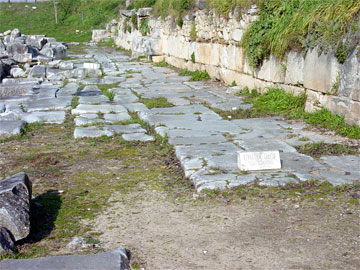Thanks to those who contributed comments to yesterday’s post, and to those who communicated with me by email. As always, I am encouraged, instructed, and challenged by your insights.
When I think about the relationship of technology and theology, I wonder where to start. As a biblically-informed Christian, I know I’m going to start with the Bible. But it’s not as if I can turn to a chapter on the Internet and its applications. Technology does appear in the Bible (farm implements, kitchen tools, weapons, etc.), but it doesn’t get a whole lot of attention.
Positive Uses of Technology in Scripture
 One of the positive uses of technology in Scripture has to do with the spread the Gospel and the nurturing of communities to which the Gospel gave birth. For example, the impressively rapid growth of early Christianity depended, to an extent, on the Roman roads that made travel so much easier than it had been before. Yes, of course the Holy Spirit was the chief reason for the explosion of Christian faith throughout the Roman world. But the Spirit made good use of Roman roads. The Romans were, for their time of history, experts in the technology of road building. This facilitated, not only the economic prosperity of the Roman Empire, but also the geographic spread of Christianity. It should be noted, however, that the system of Roman roads also supported the propagation of pagan alternatives to Christianity. In the first century A.D., the Roman west was being flooded by religions from the east, including Mithraism, the worship of Isis, and so forth. (Photo: A Roman road used by the Apostle Paul, the Via Egnatia outside of Philippi. Photo from www.HolyLandPhotos.org.)
One of the positive uses of technology in Scripture has to do with the spread the Gospel and the nurturing of communities to which the Gospel gave birth. For example, the impressively rapid growth of early Christianity depended, to an extent, on the Roman roads that made travel so much easier than it had been before. Yes, of course the Holy Spirit was the chief reason for the explosion of Christian faith throughout the Roman world. But the Spirit made good use of Roman roads. The Romans were, for their time of history, experts in the technology of road building. This facilitated, not only the economic prosperity of the Roman Empire, but also the geographic spread of Christianity. It should be noted, however, that the system of Roman roads also supported the propagation of pagan alternatives to Christianity. In the first century A.D., the Roman west was being flooded by religions from the east, including Mithraism, the worship of Isis, and so forth. (Photo: A Roman road used by the Apostle Paul, the Via Egnatia outside of Philippi. Photo from www.HolyLandPhotos.org.)Another positive use of technology that supported the growth of the early Christian church was letter writing. Though we might not think of letter writing as using technology, in fact letter writing in the Roman world depended on the production of writing materials (usually papyrus, a paper-like substance), ink, etc. The delivery of letters from one place to another usually included means of transportation (roads, ships, etc.).
 The Apostle Paul was, as far as we know, the first Christian to write letters as a part of his evangelistic effort. We take for granted this fact, but it was groundbreaking in its time. Paul used the familiar form of the personal letter, adapting it for the purpose of nurturing communities he had planted or intended to visit. (Photo: A portion of a papyrus letter, P.Duk.inv. 98.)
The Apostle Paul was, as far as we know, the first Christian to write letters as a part of his evangelistic effort. We take for granted this fact, but it was groundbreaking in its time. Paul used the familiar form of the personal letter, adapting it for the purpose of nurturing communities he had planted or intended to visit. (Photo: A portion of a papyrus letter, P.Duk.inv. 98.)In other words, he didn’t just use the technology available to him. Rather, he adapted it creatively and critically. For example, it was common for a first-century letter writer to offer thanks to the gods at the beginning of a letter. Paul does similarly, though thanking the (one) “God and Father of our Lord Jesus Christ” (2 Cor 1:3).
Paul understood that his letters were valuable as tools of communication that took the place of his personal presence. Yet he also sensed that letters could never adequately represent him. Hence he was eager to be with his churches, and often promised to visit them personally (for example, 1 Thess 2:17-3:10).
Paul also experienced the limitation of letters as a form of communication. Before writing the letter we know as 1 Corinthians, he had written an earlier letter to the church in Corinth (1 Cor 5:9). This letter led to some considerable confusing on the part of the Corinthians believers, which Paul tried to clear up in his next letter (so-called 1 Corinthians).
The use of Roman technology by the early Christians to spread the Gospel shows how it can be contribute to God’s work in the world in a positive way. But both Roman roads and pastoral letters had certain downsides as well. In my next post I’ll examine a passage that emphasizes the negative implications of technology.

